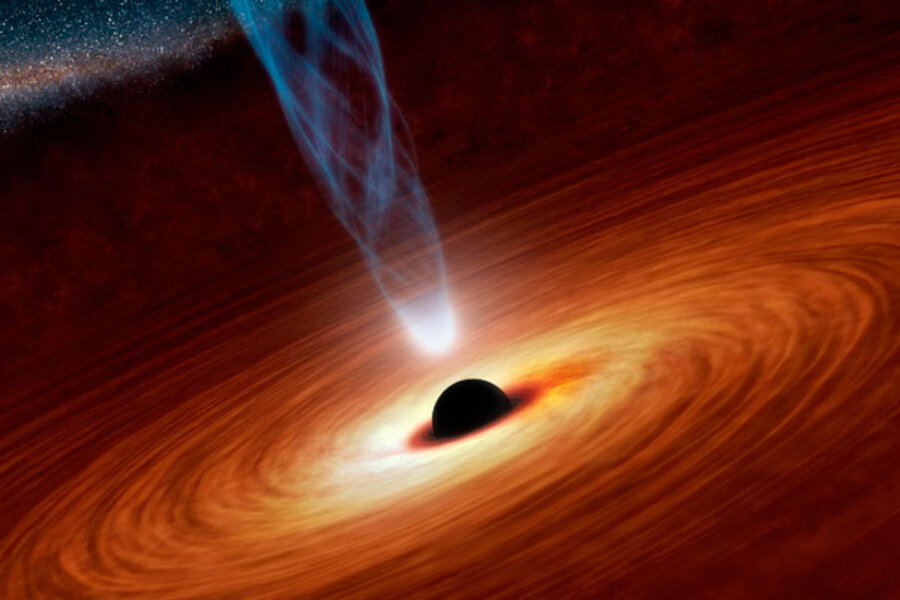Potential 'missing link' black hole only confuses scientists more
Loading...
The quest to find a missing link between the stellar black holes found throughout galaxies and the supermassive black holes at galactic cores has led to the discovery of a puzzling black hole that only raises more questions.
The black hole shines so brightly in X-rays that some scientists thought it might be a midsize black hole that fit neatly between the two known varieties. Instead, research has shown it is fairly small as black holes go, and so is shining far more brightly than a black hole of its mass has a right to shine based on current theory.
The discovery could rule out at least some candidates that researchers hoped might be the midsize black holes – the objects from which the behemoth black holes at the centers of galaxies formed, some scientists suggest.
Black holes are objects so dense that their gravity prevents even light from escaping. Small, stellar black holes form from the collapse and explosion of stars tens of times more massive than the sun. By contrast, supermassive black holes range from about 1 million to more than a billion times the mass of the sun.
The black hole in question, nestled in the arm of the spectacular Pinwheel Galaxy some 21 million light years away, was thought to have been one of the best candidates to represent a group known as intermediate-mass black holes. These are thought to range from 100 to 1,000 times the sun's mass. The hope that this candidate, labelled M101 ULX-1, could be a winner was based in part on the intensity of the object's X-ray emissions.
“One always hopes that you'll be able to present this result: We finally found an intermediate-mass black hole unambiguously,” says Joel Bregman, an astrophysicist at the University of Michigan and a member of the team reporting the results in Thursday's issue of the journal Nature.
That clearly isn't the case. On the other hand, he adds, nature was merely doing what it does, leaving it to the team, led by Ji-Feg Liu, with the Chinese National Academy of Sciences in Beijing, to discover what was really going on.
Although no light can escape from a black hole, the effect its gravity has on matter than hasn't fallen in yet can generate X-ray emissions. This matter forms an extended disk that slowly spirals in toward the black hole's event horizon – essentially, the point of no return.
The infalling matter orbits at ever-increasing speeds as the black hole draws it closer. The innermost region of the accretion disk is traveling the fastest, whipping around the black hole at more than 2 million miles an hour. Friction between this region and its surrounding regions raises the temperature there to levels that generate the X-rays, explains Dr. Bregman.
But those X-rays also exert outward pressure on the matter spiraling in. If gravity wins, the black hole keeps feeding, adding to its mass, and generating more X-rays. But at some point, X-ray emissions can grow so intense that their outward pressure can, in effect, starve the black hole, putting an upper limit on object's brightness in X-rays.
Theories predict where this so-called Eddington Limit is likely to be for black holes over a range of masses. The brightness of the black hole in the Pinwhell Galaxy hinted that it was massive enough to qualify as the elusive intermediate-mass black hole. Moreover, the energy level of the X-ray emissions fell into a range that theories predict for intermediate-range black holes. This is a class researchers have dubbed ultra-luminous X-ray sources.
Dr. Liu and his team set out to measure the black hole's mass for the answer. During a lull in the black hole's emissions, they spotted a star at the black hole's location – the black hole's companion and the likely source of the matter falling into it.
By determining the type of star and its characteristics, and then by measuring measuring the wobble the black hole imparted to the companion star's spectrum, they estimated the black hole's mass at no less than five times more massive than the sun, and more likely 20 to 30 times the sun's mass. Their hoped-for candidate for an intermediate-mass black hole turned out to be a relative lightweight.
But that left the question of how such a lightweight could masquerade as a middleweight.
Some researchers have long doubted ultra-luminous X-ray sources herald a middleweight black hole, says Mitchell Begelman, an astrophysicist at the University of Colorado at Boulder. Indeed, he says, this view “is now fairly common.”
He offers some explanations for how X-ray emissions from these sources could skirt their their theoretical limits.
Calculations have suggested that as the accretion disk reaches its Eddington Limit, it puffs up to form a funnel. This can concentrate X-ray emissions and send them in one direction, much the same way the cone-shaped reflector in a flashlight concentrates light in one direction. Stare directly into the cone, Dr. Begelman says, and theXx-ray emissions appear brighter.
“It's the same amount of radiation, but concentrated into a smaller solid angle,” he says.
A third possibility involves a process dubbed photon bubbles, which also allows for X-ray emissions to appear to exceed the disk's limit, even though the limit actually isn't violated.







